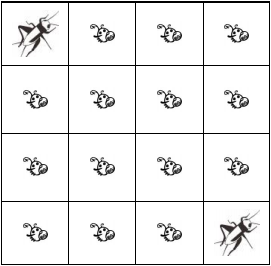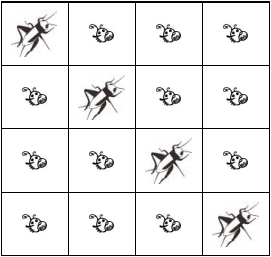【NOI2016】网格
问题描述
跳蚤国王和蛐蛐国王在玩一个游戏。
他们在一个 $n$ 行 $m$ 列的网格上排兵布阵。其中的 $c$ 个格子中 $(0 \leq c \leq nm)$,每个格子有一只蛐蛐,其余的格子中,每个格子有一只跳蚤。
我们称占据的格子有公共边的两只跳蚤是相邻的。
我们称两只跳蚤是连通的,当且仅当这两只跳蚤相邻,或存在另一只跳蚤与这两只跳蚤都连通。
现在,蛐蛐国王希望,将某些(零个,一个或多个)跳蚤替换成蛐蛐,使得在此之后存在至少两只跳蚤不连通。
例如:我们用图
表示一只跳蚤,用图
表示一只蛐蛐,那么左图描述了一个 $n=4, \ m=4, \ c=2$的情况。
这种情况下蛐蛐国王可以通过将第二行第二列,和第三行第三列的两只跳蚤替换为蛐蛐,从而达成他的希望,如右图所示。并且,不存在更优的方案,但是可能存在其他替换两只跳蚤的方案。
你需要首先判断蛐蛐国王的希望能否被达成。如果能够达成,你还需要最小化被替换的跳蚤的个数。
输入格式
每个输入文件包含多组数据。
输入文件的第一行只有一个整数 $T$,表示数据的组数。
接下来依次输入 $T$ 组数据,每组数据的第一行包含三个整数 $n, m, c$。
接下来 $c$ 行,每行包含两个整数 $x, y$ 表示第 $x$ 行,第 $y$ 列的格子被一个蛐蛐占据。每一组数据当中,同一个蛐蛐不会被多次描述。
同一行相邻的整数之间由一个空格隔开。
输出格式
对于每一组数据依次输出一行答案。
如果这组数据中,蛐蛐国王的希望不能被达成,输出
-1。否则,输出被替换的跳蚤的个数的最小值。
样例输入
4
4 4 2
1 1
4 4
2 3 1
1 2
2 2 2
1 1
2 2
1 1 0
样例输出
2
1
0
-1
提示
对于所有的数据,$1 \leq n,m \leq 10^9, \ 0 \leq c \leq \text{min}(nm,10^5),\ 1 \leq x \leq n,\ 1 \leq y \leq m,\ 1 \leq T \leq 20$。
我们记 $\sum c$ 为某个测试点中,其 $T$ 组输入数据的所有 $c$ 的总和,则保证 $\sum c≤10^5$。
这题乍一看感觉很麻烦,但思索一下就能发现答案显然只可能是$-1,0,1,2$之一。考虑依次判断。
容易发现答案为$-1$当且仅当图中跳蚤数量小于二,或跳蚤数量等于二且相邻。
否则答案为$0$当且仅当原图中存在至少两只不连通的跳蚤。
否则答案为$1$当且仅当图中存在割点,否则答案为$2$
然后发现棋盘很大,不可能把完整的图建出来,考虑只把关键点拿出来讨论。
容易发现可能成为割点的点只可能是障碍格子八连通的点,考虑只将这些点拿出来,但容易发现当有一个障碍在棋盘边缘时,这样做会出问题,那么考虑再往外拓展一圈,即拿出24个点来。
然后只需要跑个Tarjan求割点就行了。注意到判断答案是否为$0$只需要将八连通的障碍合并后讨论它相邻的格子就行了。
最后需要注意,上面的建图还是有反例,就是当两个障碍刚好在对角,且中间有三个格子时。
这个只需要最后判断割点八连通格子中是否有障碍就行了。
代码:
1 |
|

